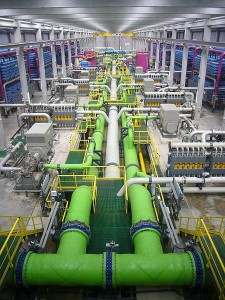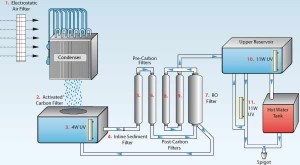Reverse osmosis/ water treatment in an apartment society
 One of the major practises of purifying water in apartments today is Reverse Osmosis (R.O). This system purifies the water by removing salts and ions and has become quite popular in many apartment societies. There are various water purifying machines which run on reverse osmosis technology and purify the drinking water in both individual houses and apartment societies. Let’s get in to the details about the entire concept of Reverse Osmosis;
One of the major practises of purifying water in apartments today is Reverse Osmosis (R.O). This system purifies the water by removing salts and ions and has become quite popular in many apartment societies. There are various water purifying machines which run on reverse osmosis technology and purify the drinking water in both individual houses and apartment societies. Let’s get in to the details about the entire concept of Reverse Osmosis;
What is Reverse Osmosis?
It is a membrane-technology (process for separation of gaseous or liquid streams using membrane technology) filtration method which eliminates the large molecules and ions from the solutions by applying pressure to the solution when it is on one side of a selective membrane. With this the solute is retained on the pressurized side of the membrane and the pure solvent is allowed to pass to the other side. Altogether, the membrane does not allow large molecules or ions through the pores and allows only the smaller components of the solution to pass.
 How does a Reverse Osmosis system work in an apartment society?
How does a Reverse Osmosis system work in an apartment society?
Earlier an apartment society just had facilities of ultraviolet and filtration units. Due to the increased amount of minerals found in water, various group-housing societies in cities like Punjab, Noida and others have come up with domestic water purification systems which have led to the demand of industrial RO systems all over. Each society installs an RO plant based on the number of people in the apartment. In a Reverse Osmosis system, the dissolved inorganic solids (such as salts) are eliminated from a solution (water). This is done by household water pressure pushing the tap water through a semi permeable sheath. This sheath, which looks like a cellophane tape allows only the water to pass through leaving all the impurities or contaminates behind. However, these impurities are flushed down the drain. Apart from just this, various apartment societies have an RO system with storage facility and auto power cut facility.
The RO machines are produced in different types and the basic types of reverse osmosis systems lies on the number and kinds of membranes or filters used in an apartment society. Apart from just the systems, the RO is also based on the filters and membranes used. Industrial purification systems have a larger capacity in the range of 500 lph and upwards, and are used in industries as well as group housing societies.
 The following are the steps through which thewater is purified;
The following are the steps through which thewater is purified;
- It has a sediment filter to trap particles, including rust and calcium carbonate.
- It has another sediment filter with smaller pores.(This can also exceed based on the quantity of the population)
- It has an activated carbon filter to trap organic chemicals and chlorine. This will eventually attack and degrade the TFC reverse osmosis membranes.
- There is an optional second carbon filter to capture the chemicals which are not removed by the RO membrane.
- There is an optional ultra-violet lamp for sterilizing any microbes that may escape filtering by the reverse osmosis membrane in the machine.
The advantages of a Reverse Osmosis system:
- This machine has opted water purifying techniques which are commonly used for drinking water purification.
- A RO machine can be easily fit or connected to the water supply point in an apartment society in a spacious place.
- This technique of Reverse Osmosis has one of the highest contaminant rejection rates of any water filtering system.
- They are environment friendly and do not use any chemicals or by products which harm the environment.
- An apartment society can have a separate storage tank for the rejected water, which can be further used by the apartment members through their pipelines.
- RO gives a better quality of water and eliminates all the chemical and biological contaminants. It also improves the taste, odour and appearance of water. It also uses a minimal amount of electricity.
- Since the large RO in an apartment society has various pipelines, most of the apartment members might fret thinking about the moss accumulated in the pipes. In such cases, individual apartment owners can also install a convenient RO in their kitchen.
 The disadvantages of a Reverse Osmosis system:
The disadvantages of a Reverse Osmosis system:
- This process involves an enormous amount of water in an apartment society, which eventually leads to the elimination of quite a large amount of water. The loss of water can be as high as 80 percent with only 20 percent of the intake being recovered.
- If the apartment society drains the rejected water, it can be a threat to the septic systems in the apartment due to the excess flow of water.
- Since there will be quite a number of pipes connected to each apartment, there are chances of contamination through tiny leaks.
- If the incoming water flow does not have high pressure, the RO filter will not work optimally.
- Although RO water purifiers are said to be the most effective, one of the major disadvantages are that they need electricity to operate which eventually means that they can be useless in areas where power is erratic.
- It removes healthy and naturally occurring minerals that are found in water. If drinking water is deprived of such minerals, it could be unhealthy and less likely for drinking.
How is an RO useful for an apartment society?
Eliminates the hard water:
Hard water in an apartment society corrodes all the geysers, pressure cookers, vessels with water, pipes and so on. This further causes poor quality of washing in machines and, increases consumption of detergent and prevents soap from lathering when having a bath or washing utensils. This also causes poor cooking and spoils the taste of various culinary and fails to quench the thirst. In such cases, softeners play an important role, wherein they can be installed in large centrally installed systems which can be further attached with smaller RO unit to provide the soft water to the entire apartment society.
 Removal of the TDS (total dissolved solids):
Removal of the TDS (total dissolved solids):
An RO in an apartment also removes the TDS of well water of about 90-95 per cent. Since hard water cannot be directly fed in to a Ro system, it is important that the TDs is removed. The apartment members can share the cost of the installation of the central RO system for clean water.
What is the cost of R.O installation?
A domestic RO unit costs around Rs. 10,000 and Rs. 20,000 and has a life span of around 1.5 years.
For a 1000 litres per hour industrial RO unit, the cost is around Rs. 2,50,000 with a PVC pipe system. The price for the same capacity unit with stainless steel system can go up to Rs. 3,10,000.
These huge systems are generally installed in societies of close to between 75-100 flats.
Separate water testing of water in the area is carried on before installing the water purifier.











